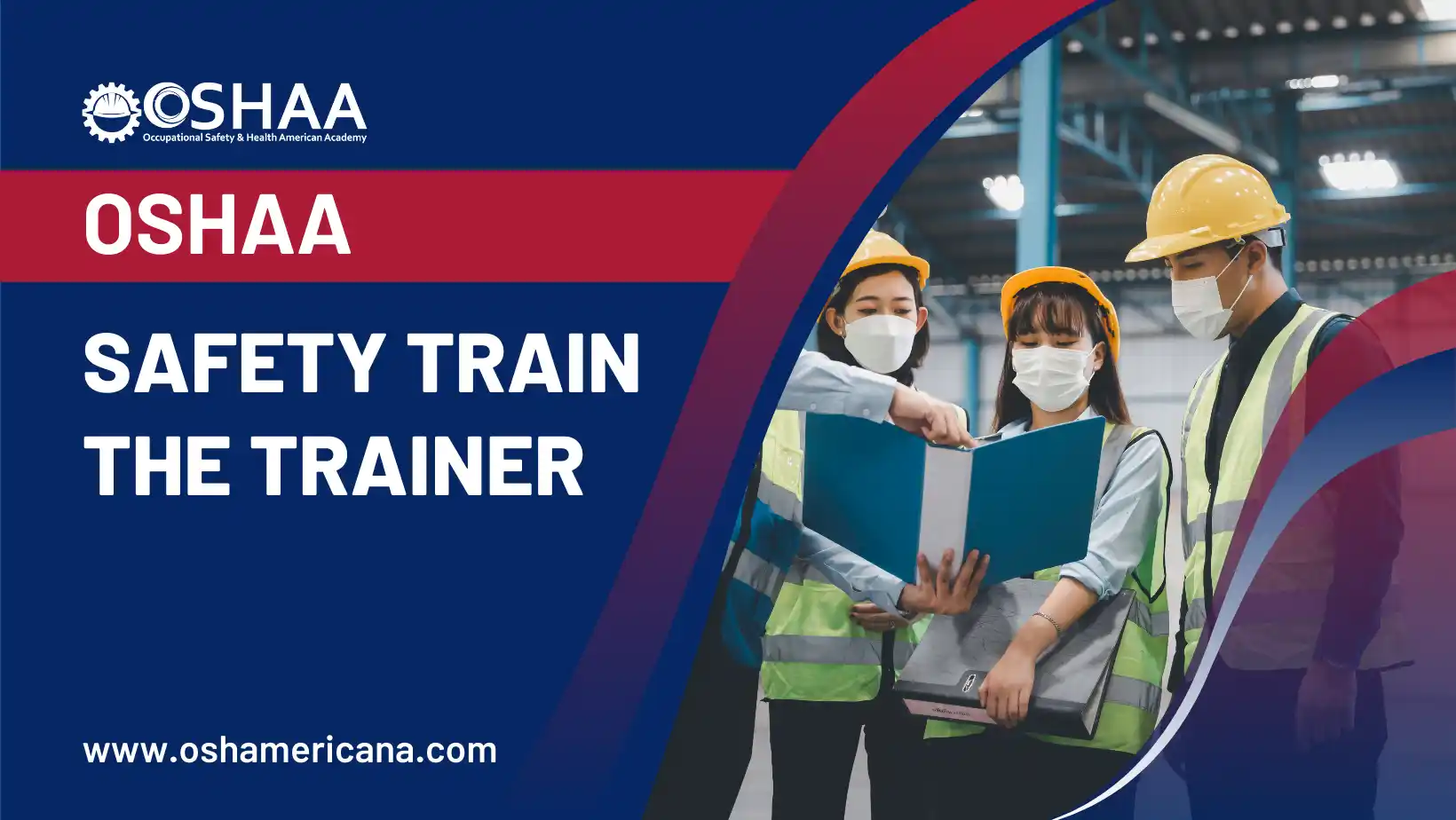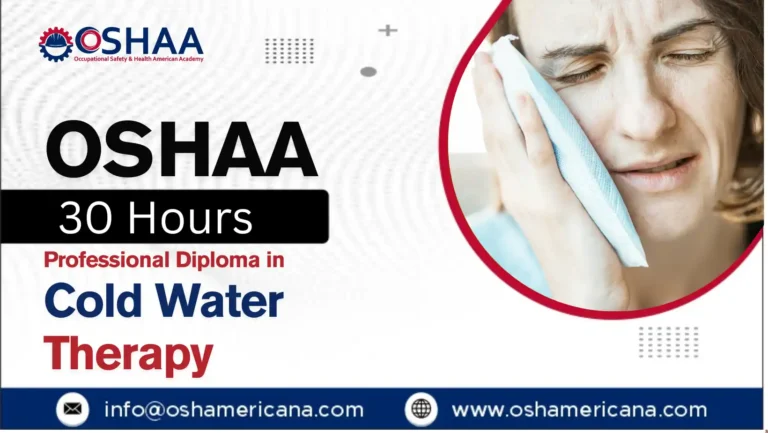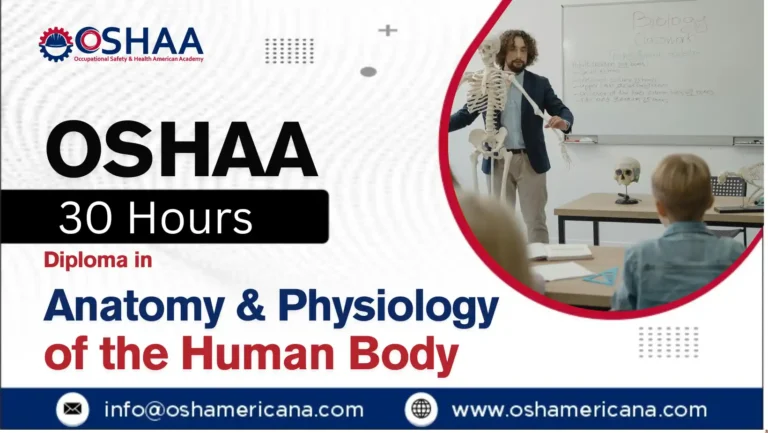Enhance workplace safety and compliance with the OSHAA 30-Hours Professional Diploma in Safe Manual Handling Skills. Prevent injuries and boost productivity.
The OSHAA 30-Hours Professional Diploma in Safe Manual Handling Skills is a comprehensive training program designed to address one of the most common causes of workplace injuries across industries. Manual handling tasks, including lifting, carrying, pushing, pulling, and moving objects, are integral to daily operations in sectors such as healthcare, construction, warehousing, and logistics. However, when performed incorrectly, these activities can result in serious musculoskeletal injuries, particularly affecting the back, shoulders, and neck. Such injuries not only compromise employee health but also lead to significant financial costs, reduced productivity, and potential legal liabilities for organizations.
This diploma provides professionals with the essential knowledge and practical skills required to implement safe manual handling practices in the workplace. By focusing on correct techniques, risk assessment, and injury prevention strategies, the OSHAA 30-Hours Professional Diploma in Safe Manual Handling Skills empowers participants to reduce hazards and foster a culture of safety. The program emphasizes compliance with international standards and regulatory frameworks, including the UK’s Manual Handling Operations Regulations (MHOR), ensuring that learners are fully equipped to meet legal obligations while protecting the wellbeing of employees.
The importance of safe manual handling extends beyond compliance. It is a cornerstone of occupational health and safety, directly influencing workforce morale, efficiency, and long-term sustainability. Through this diploma, learners gain the ability to identify risks, apply ergonomic principles, and implement effective safety measures that minimize the likelihood of accidents. By mastering these skills, professionals contribute to safer working environments, improved operational performance, and enhanced organizational resilience.
Investing in the OSHAA 30-Hours Professional Diploma in Safe Manual Handling Skills is not only a step toward personal career advancement but also a strategic decision for businesses committed to safeguarding their workforce. For employees, it provides a valuable qualification that strengthens professional development and opens opportunities in industries where safety expertise is highly valued. For employers, it ensures compliance, reduces compensation claims, and promotes a healthier, more productive workforce.
This program is designed to deliver lasting impact by equipping participants with practical, real-world skills that can be applied immediately in their professional roles. Whether you are an individual seeking to enhance your qualifications or an organization aiming to improve workplace safety standards, the OSHAA 30-Hours Professional Diploma in Safe Manual Handling Skills offers the tools, knowledge, and certification needed to make a measurable difference. By completing this course, you take an active role in preventing unnecessary injuries, boosting productivity, and ensuring compliance with occupational safety regulations, ultimately contributing to a safer and more sustainable workplace environment.
OSHAA 30-Hours Professional Diploma in Safe Manual Handling Skills
To enroll in the OSHAA 30-Hours Professional Diploma in Safe Manual Handling Skills, learners are expected to meet the following criteria:
1. Age Requirement
- Applicants must be at least 18 years of age to register for the OSHAA 30-Hours Professional Diploma in Safe Manual Handling Skills. This minimum age requirement ensures that participants have the maturity, responsibility, and physical capability to engage with the practical aspects of manual handling training while applying the knowledge effectively in professional environments.
2. Educational Background
- A minimum of a high school diploma or equivalent qualification is recommended for enrollment in the OSHAA 30-Hours Professional Diploma in Safe Manual Handling Skills. While this level of education is sufficient to begin the program, individuals with higher education in fields such as occupational health, physiotherapy, ergonomics, or industrial management will find it advantageous. Advanced academic backgrounds allow learners to connect theoretical knowledge with practical applications, strengthening their ability to implement safe manual handling practices in compliance with workplace safety standards.
3. Work Experience
- Prior work experience is not mandatory to pursue the OSHAA 30-Hours Professional Diploma in Safe Manual Handling Skills. However, professionals already working in industries such as healthcare, construction, logistics, warehousing, or manufacturing may benefit from their practical exposure, as it allows them to directly apply the course content to real-world scenarios. For those new to the field, the diploma serves as a strong foundation to build essential skills in occupational safety, risk management, and compliance with manual handling regulations.
4. English Proficiency
- Since the OSHAA 30-Hours Professional Diploma in Safe Manual Handling Skills is delivered in English, learners must be able to read, write, and communicate effectively in the language. Proficiency in English is essential to fully understand course materials, interpret regulatory requirements, and apply safety standards in diverse workplace settings. This ensures that participants can engage with international occupational safety guidelines and implement them accurately in their professional roles.
The eligibility requirements for the OSHAA 30-Hours Professional Diploma in Safe Manual Handling Skills are designed to ensure that learners are well-prepared to succeed in this professional training program. By meeting these criteria, participants can maximize the value of their learning experience, strengthen their qualifications, and contribute to safer, healthier, and more productive workplaces. This diploma not only enhances individual career development but also supports organizations in achieving compliance, reducing risks, and promoting a culture of occupational safety and health.
Study Units
Learning Outcomes
Introduction to Manual Handling and Associated Risks (2 Hours)
- Understand the definition and scope of manual handling.
- Identify common risks associated with manual handling tasks.
- Recognise the impact of poor manual handling on health and safety in the workplace.
- Learn the legal requirements and regulations governing manual handling practices.
Principles of Safe Manual Handling (3 Hours)
- Gain knowledge of the key principles for ensuring safe manual handling.
- Understand the role of posture and body alignment in preventing injury.
- Learn how to assess manual handling tasks for potential risks.
- Develop an understanding of the importance of proper lifting techniques.
Techniques for Lifting, Carrying, Pushing, and Pulling (4 Hours)
- Master the correct techniques for lifting, carrying, pushing, and pulling in a safe manner.
- Understand the importance of using proper body mechanics during manual handling.
- Learn the appropriate steps to take when performing these tasks to reduce strain and prevent injury.
- Recognise when assistance or mechanical aids should be used to safely carry out manual handling tasks.
Risk Assessment and Control Measures in Manual Handling (4 Hours)
- Learn how to carry out a risk assessment for manual handling activities.
- Understand the process of identifying hazards and assessing risks related to manual handling.
- Develop strategies to control or eliminate risks in manual handling tasks.
- Understand the significance of control measures such as training, equipment, and organisational procedures.
Practical Application of Manual Handling Techniques (5 Hours)
- Apply the learned principles and techniques in practical scenarios.
- Conduct hands-on exercises to practice safe manual handling techniques.
- Learn how to assess real-life manual handling situations and adjust approaches accordingly.
- Gain confidence in performing manual handling tasks safely in various work environments.
Ergonomics and Body Mechanics in Manual Handling (4 Hours)
- Understand the role of ergonomics in reducing strain during manual handling tasks.
- Learn how to implement ergonomic principles to improve workplace safety.
- Explore the importance of body mechanics and their role in preventing musculoskeletal injuries.
- Learn how to adapt tasks and workspaces to reduce the risk of injury.
Workplace Adaptations and Equipment for Safe Manual Handling (4 Hours)
- Gain knowledge on the use of mechanical aids and equipment to assist with manual handling.
- Understand how to make workplace adaptations to support safe manual handling practices.
- Learn about different types of lifting aids and when to use them.
- Develop strategies to ensure the appropriate use of manual handling equipment in your workplace.
Creating a Safety Culture and Compliance in the Workplace (4 Hours)
- Learn how to foster a culture of safety within the workplace.
- Understand the importance of compliance with manual handling regulations and company policies.
- Learn how to communicate safety procedures effectively to staff.
- Develop skills in promoting safety awareness and best practices among employees.
The OSHAA 30-Hours Professional Diploma in Safe Manual Handling Skills delivers a wide range of benefits for professionals, organizations, and stakeholders committed to workplace safety and compliance. This globally recognized program is designed to reduce the risks associated with manual handling, enhance regulatory compliance, and strengthen professional development opportunities across industries such as healthcare, construction, logistics, warehousing, and manufacturing. By completing this diploma, learners gain advanced knowledge, practical skills, and internationally relevant expertise that contribute to safer workplaces, improved productivity, and long-term organizational success.
1. Comprehensive Knowledge of Manual Handling
- Participants gain a thorough understanding of safe manual handling techniques, including lifting, carrying, pushing, and pulling. This knowledge ensures they can apply best practices to reduce risks and prevent injuries in diverse workplace environments.
2. Regulatory Compliance and Legal Protection
- The OSHAA 30-Hours Professional Diploma in Safe Manual Handling Skills equips learners with the expertise to comply with international safety regulations, including the UK’s Manual Handling Operations Regulations (MHOR). This compliance protects organizations from legal liabilities and costly penalties.
3. Workplace Safety and Injury Reduction
- By mastering safe handling practices, professionals can significantly reduce musculoskeletal injuries such as back, shoulder, and neck strains. This proactive approach enhances employee safety while minimizing workplace accidents.
4. Professional Development and Career Advancement
- Completing the OSHAA 30-Hours Professional Diploma in Safe Manual Handling Skills diploma strengthens professional qualifications, making learners more competitive in industries where safety expertise is highly valued. It opens opportunities for roles such as safety officer, compliance manager, or health and safety trainer.
5. Cost Savings and Operational Efficiency
- Effective manual handling reduces compensation claims, medical costs, and downtime caused by workplace injuries. Organizations benefit from improved efficiency, reduced expenses, and stronger overall performance.
6. Leadership and Communication Skills
- The OSHAA 30-Hours Professional Diploma in Safe Manual Handling Skills program develops leadership and communication abilities, enabling participants to train teams, enforce safety protocols, and promote a culture of compliance. These skills are essential for managing safety initiatives effectively.
7. Enhanced Worker Well-being and Productivity
- A safe workplace directly contributes to employee morale, job satisfaction, and productivity. The OSHAA 30-Hours Professional Diploma in Safe Manual Handling Skills empowers professionals to create healthier environments where employees can thrive.
8. Risk Assessment and Hazard Identification
- Learners acquire advanced skills in identifying risks associated with manual handling tasks. They learn to conduct assessments, prioritize hazards, and implement preventive measures that protect both workers and organizational assets.
9. Emergency Preparedness and Response
- The OSHAA 30-Hours Professional Diploma in Safe Manual Handling Skills course provides knowledge on developing emergency response strategies for incidents related to manual handling. This ensures organizations are prepared to act quickly and effectively in case of accidents or injuries.
10. Accident Investigation and Prevention
- Participants learn how to investigate workplace incidents, identify root causes, and implement corrective actions. This systematic approach prevents recurrence and strengthens overall safety management systems.
11. Continuous Improvement and Innovation
- The diploma encourages a culture of continuous improvement by teaching learners how to evaluate safety performance, adopt innovative practices, and refine manual handling procedures over time.
12. Global Recognition and Industry Relevance
- The OSHAA 30-Hours Professional Diploma in Safe Manual Handling Skills is internationally recognized, making it a valuable credential for professionals seeking opportunities in global industries where safety standards are critical.
13. Strategic Application Across Industries
- The program is relevant to multiple sectors, including healthcare, construction, logistics, and manufacturing. Learners gain versatile skills that can be applied across industries to improve safety and compliance.
14. Improved Organizational Reputation
- By prioritizing safe manual handling, organizations demonstrate their commitment to employee wellbeing and corporate social responsibility. This enhances reputation, builds trust with stakeholders, and supports long-term sustainability.
15. Lifelong Professional Value
- The OSHAA 30-Hours Professional Diploma in Safe Manual Handling Skills provides lasting value by equipping learners with transferable skills that remain relevant throughout their careers, regardless of industry or role.
The benefits of the OSHAA 30-Hours Professional Diploma in Safe Manual Handling Skills extend far beyond compliance. This program empowers professionals to lead safety initiatives, protect employees, and drive organizational success while contributing to a safer and healthier global workforce. It is not just a qualification but a transformative step toward excellence in occupational safety, regulatory compliance, and professional development.
The OSHAA 30-Hours Professional Diploma in Safe Manual Handling Skills is designed for professionals, organizations, and stakeholders who are committed to improving workplace safety, ensuring OSHA compliance, and advancing professional development in industries where manual handling is a daily requirement. This globally recognized program is highly relevant to sectors such as healthcare, construction, logistics, warehousing, oil and gas, and manufacturing, where safe manual handling practices are critical to reducing injuries, maintaining productivity, and meeting international workplace safety standards. By addressing both regulatory compliance and practical applications, the course provides learners with the expertise to enhance safety performance, protect employees, and strengthen organizational efficiency.
1. Safety Managers
- Oversee workplace safety programs and ensure compliance with OSHA standards and manual handling regulations.
- The OSHAA 30-Hours Professional Diploma in Safe Manual Handling Skills course equips them with advanced strategies to reduce risks associated with lifting, carrying, and moving loads.
- They gain the ability to design and implement safe manual handling policies across organizations.
- Training enhances their leadership role in promoting compliance and operational efficiency.
2. Operations Supervisors
- Manage daily operations in industries where manual handling tasks are routine.
- The diploma helps them integrate safe handling practices into workflows without disrupting productivity.
- They develop skills to identify hazards and enforce workplace safety standards.
- Training ensures they can balance efficiency with compliance and employee wellbeing.
3. HSE Officers (Health, Safety, and Environment Officers)
- Responsible for monitoring and enforcing occupational safety and health practices.
- The OSHAA 30-Hours Professional Diploma in Safe Manual Handling Skills program strengthens their expertise in hazard identification and injury prevention.
- They gain advanced knowledge of OSHA compliance and manual handling regulations.
- This supports their role in creating safer, healthier, and more compliant workplaces.
4. Healthcare Professionals
- Frequently perform manual handling tasks such as lifting patients or moving equipment.
- The diploma provides them with safe handling techniques to prevent musculoskeletal injuries.
- They gain skills to protect both staff and patients while ensuring compliance with safety standards.
- Training supports their role in maintaining a safe and efficient healthcare environment.
5. Construction Site Supervisors
- Oversee teams working in physically demanding environments with high manual handling risks.
- The OSHAA 30-Hours Professional Diploma in Safe Manual Handling Skills course equips them with practical tools to prevent accidents and enforce OSHA standards.
- They develop skills to conduct site inspections and implement corrective actions.
- Training enhances their ability to protect workers while maintaining project timelines.
6. Logistics and Warehousing Staff
- Handle goods, materials, and equipment as part of daily operations.
- The diploma provides them with ergonomic techniques to reduce strain and injury.
- They gain confidence in applying OSHA-compliant safety practices.
- Training improves efficiency while reducing workplace accidents and downtime.
7. Oil and Gas Professionals
- Work in one of the most hazardous industries with strict safety requirements.
- The OSHAA 30-Hours Professional Diploma in Safe Manual Handling Skills diploma provides specialized knowledge in safe manual handling for high-risk environments.
- They gain the ability to apply OSHA compliance to offshore and onshore operations.
- This ensures safer environments while reducing costly incidents and operational risks.
8. Manufacturing and Industrial Workers
- Engage in repetitive manual handling tasks involving machinery and heavy loads.
- The course provides them with practical knowledge to identify hazards and follow safety procedures.
- They gain skills to reduce injuries and improve workplace safety standards.
- Training enhances productivity while ensuring compliance with OSHA regulations.
9. Human Resource Professionals
- Responsible for employee wellbeing, training, and organizational compliance.
- The diploma enables them to design effective workplace safety training programs.
- They gain insights into regulatory compliance and employee protection strategies.
- This supports HR’s role in reducing liabilities and fostering a culture of safety.
10. Business Owners and Senior Executives
- Hold ultimate responsibility for organizational compliance and employee wellbeing.
- The OSHAA 30-Hours Professional Diploma in Safe Manual Handling Skills course helps them understand the financial, legal, and reputational impact of safety.
- They gain insights into implementing safety management systems aligned with OSHA standards.
- Training empowers them to lead organizations toward sustainable safety excellence.
The OSHAA 30-Hours Professional Diploma in Safe Manual Handling Skills equips participants across all professional levels with advanced knowledge, practical skills, and globally recognized certification. By addressing the needs of safety managers, supervisors, healthcare professionals, engineers, and industry leaders, this program ensures that organizations achieve OSHA compliance, reduce risks, and enhance operational excellence. With its focus on professional development, workplace safety standards, and regulatory alignment, the diploma stands as a vital qualification for building safer, healthier, and more productive workplaces worldwide.







